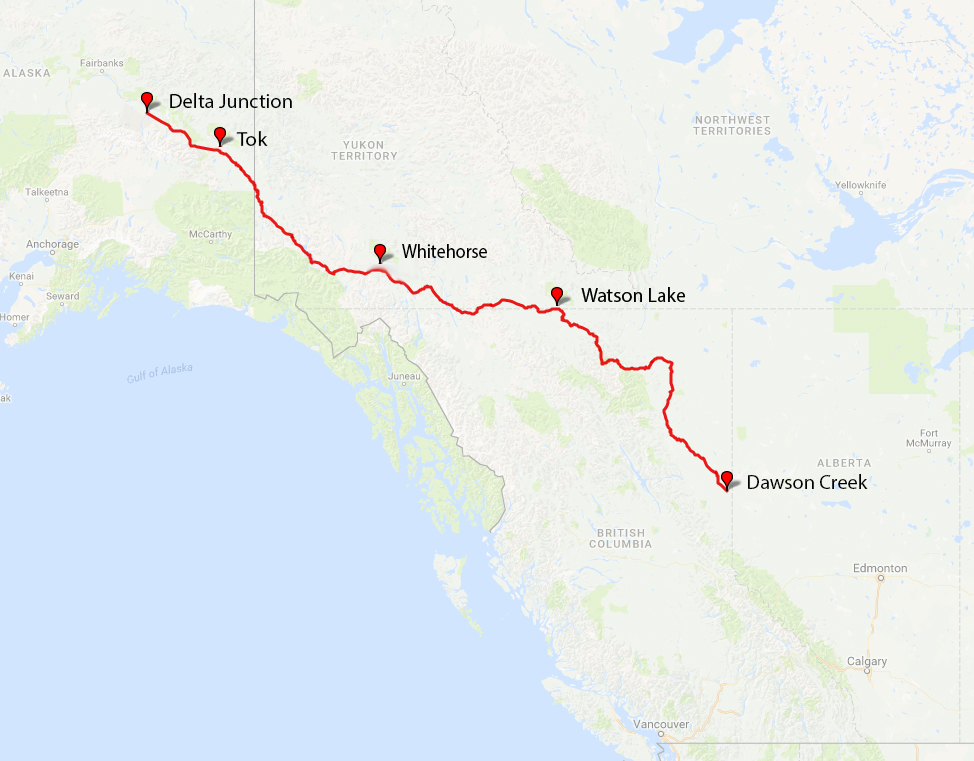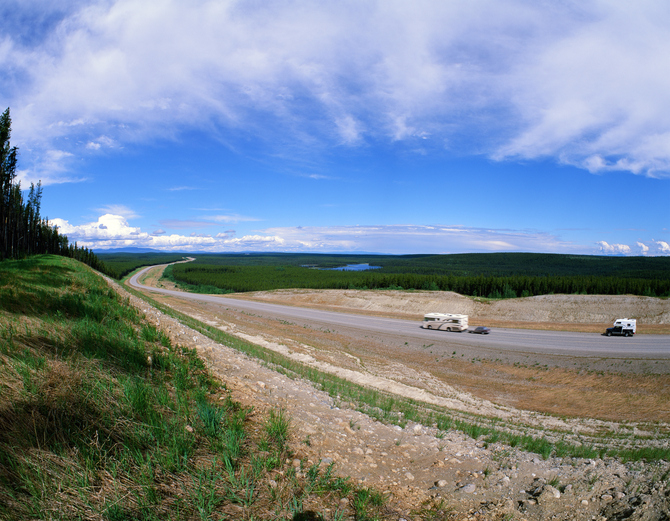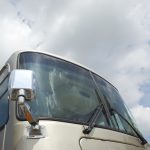Crossing 1,422 miles of rugged terrain, the Alaska Highway is unlike any road trip that you’ll experience. Long distances between towns, wide stretches of daylight during summer and unpredictable weather pose unique challenges to even the most seasoned RVers.
With this in mind, it’s important to be prepared. The following tips will help you make the trip north without a hitch.
• Fueling. It’s recommended that you “drive on the top half of your tank.” Plan for stretches of 100 to 150 miles without fuel stops, and fill ’er up whenever you get the chance.
• Keep your camera handy. The scenery along the highway is stunning. Stay on the alert for wildlife sightings along the way.
• Pay more at the pump. Expect higher fuel prices, especially in the more remote stretches of the road.
 • Fun in numbers. Prefer to travel with like-minded adventurers? Fantasy RV Tours offers RVing tours to Alaska that starts in Washington state.
• Fun in numbers. Prefer to travel with like-minded adventurers? Fantasy RV Tours offers RVing tours to Alaska that starts in Washington state.
• Watching the weather. The northern part of the Alaska Highway begins thawing in late May, and the weather turns cold again in September. Summers along the highway are stunning, with daylight extending past most folks’ bedtimes (make sure that your windows have appropriate shading for bright summer nights). Don’t be surprised by rainstorms at the height of summer. Pack clothes for rain and chilly weather just in case.
• Road conditions. Today’s paved Alaska Highway looks nothing like the rugged road of the 1940s, but it’s a good idea to stay abreast of changing driving conditions. Travel with a GPS navigation system that informs you of potential traffic problems and construction delays. You can also consult road report phone numbers, websites and weather cams that show stretches of the road so that you can look ahead (see below). Be aware that cellular reception may be spotty in some areas.
• Finding Great RV Parks. Check out RV Parks in Alaska, British Columbia and in the Yukon.
Road Condition Info
British Columbia: Dial 800-550-4997 while in the province or visit Drive BC
Yukon: Dial 511 while in the territory or visit 511 Yukon
Alaska: Dial 511 while in the state or visit 511 Alaska





Good Sam Camping
Check out this article: Bear Necessities
Anonymous
Drove the Al-Can in August, 2016. Be aware of 20 mile stretches of gravel road. We lost a tire near Destruction Bay due to the road. Their ability to do repairs is compressed because of the short summer, take your patience along. Long stretches of no cell service, consider getting your ham license and taking 2 meter radio along. The Amateurs in the Yukon monitor the radio to help out. Last, get milepost magazine and plan your trip. I planned it for two years before jumping off. I would do it again in a heartbeat!
Anonymous
Great advise!
Anonymous
Thanks for the information . Will be traveling there this summer.Are there any gravel roads to Alaska?
Anonymous
How do the bears get in and what can be done to discourage them? Are you referring to cooking odors?
Anonymous
Good info thanks, really helpful.
Anonymous
Our trip was so good we collected some friends and went back second time. There is so much to do and see there is no way I could begin to list them and tell you about all them. Just be careful and have a great time. We went in May and were gone two months. After Alaska we went down the Coast Highway into California, but that is for another trip.
Anonymous
Excellent tips.
Anonymous
Excellent information. Thanks for providing the tips.
Anonymous
Excellent tips. We have driven (truck and 19’ trailer) to Alaska from New Mexico two times, 2013 and 2015. We LOVED both trips -Alaska is amazing and a must take trip for rivers.
Be prepared! We took an extra tire, cut foil insulation (used for insulating water heaters -) buy it at a hardware store to cover your inside windows to block out light (the summer days are very, very long and can make it tough to go to sleep at 10 pm) or cold. Learn about bears and moose and what you should do if caught in a bad situation We did not, but we did not go hiking in the woods. And do top off your tank…we always carried 5 extra gallons with us just in case. Have some cash, some parks or gas stations do not take cards. Plan ahead with groceries as well – it can get hard to find good fresh food the deeper you go and if you do, it is expensive. Don’t complain about the plain, gravel RV parks, Alaska only has a few months to make their annual tourist income, so things are simple. Have a blast!
Anonymous
We drove the Alaska highway last summer and it was our first long trip in our fifth wheel. Had a great time!
Anonymous
Thank you for the intuitive article.
Anonymous
This is good information. Thanks! We are planning a two to three month road trip in our camper next year. When are the best 2-3 months to go? Any other advise will be much appreciated!
Anonymous
Having traveled the Alaskan Highway four times by car and RV I would like to add a couple of helpful tips.
1. While the roadway surface is mostly paved, every now and the you will find yourself on gravel. Watch out for on coming trucks and RV’s as small rocks can leave your some reminders of the trip. Watch for on coming fifth wheelers as most don’t have rear wheel mud flats like regular RV’s
2. Watch closely for a red flag along the roadway that is your signal to slow down for the dip in the road. If you are in a hurry a dip can ruin your front end. Slower is better.
3. Buy current edition of Milepost Magazine that gives you an idea, Fuel, resorts, food etc about what is coming up ahead but sometimes stations close so follow the fueling tip by Good Sam.
4. Plan for a month or more with best travel times in June, July and August.
5.. There are some good CD’s on RV travel done by experienced Alcan Highway travelers. Well worth the money.
Anonymous
– There is extremely limited cell phone coverage between the main towns along the Alcan Highway (Hwy 97). You might get connected within a few miles of each town, but there will be nothing in between.
– All the towers up there in northern BC and the Yukon are Bell. Our Rogers based phones (we use a 3rd party reseller that uses Rogers towers) had zero coverage between Dawson Creek and the Alcan border, when our AT&T coverage picked up. Do an internet search for “cell tower map or locations” – there are websites that show where they are on the map.
– If you really need to be constantly connected, a satellite phone is a best option.
– If you just want coverage when you hit the main towns along the Alcan Highway, get a prepaid SIM card for either Bell or Telus or one of their 3rd party resellers like Virgin, or PC Mobile and activate it before you go. We had to (try to) get one in Whitehorse, and it was a pain. We now have a T-Mobile SIM card and they work on Bell and Telus towers in Canada in case of emergency.
– A CB radio might also be a good idea if you need help. There’s a fair bit of truck traffic along the Alcan, and we’ve found that most truckers will help you.
Anonymous
We drove the AK Highway in summer of 2017 and it is truly an adventure. Scenery is fantastic. Be forewarned however, from Whitehorse on north the frost heaves are a major concern. They can really sneak up on you. Trust me, having your 40′ rig with TOAD behind nearly go airborne is no picnic. Nearly caused my wife to have a panic attack. From Destruction Bay on to Tok is especially bad.
If your rig is a little older, I would highly recommend having new shock absorbers install before heading up the AK Highway.
Anonymous
There are plenty of bears so keep a clean camp. Odor free inside and out. They can get in.